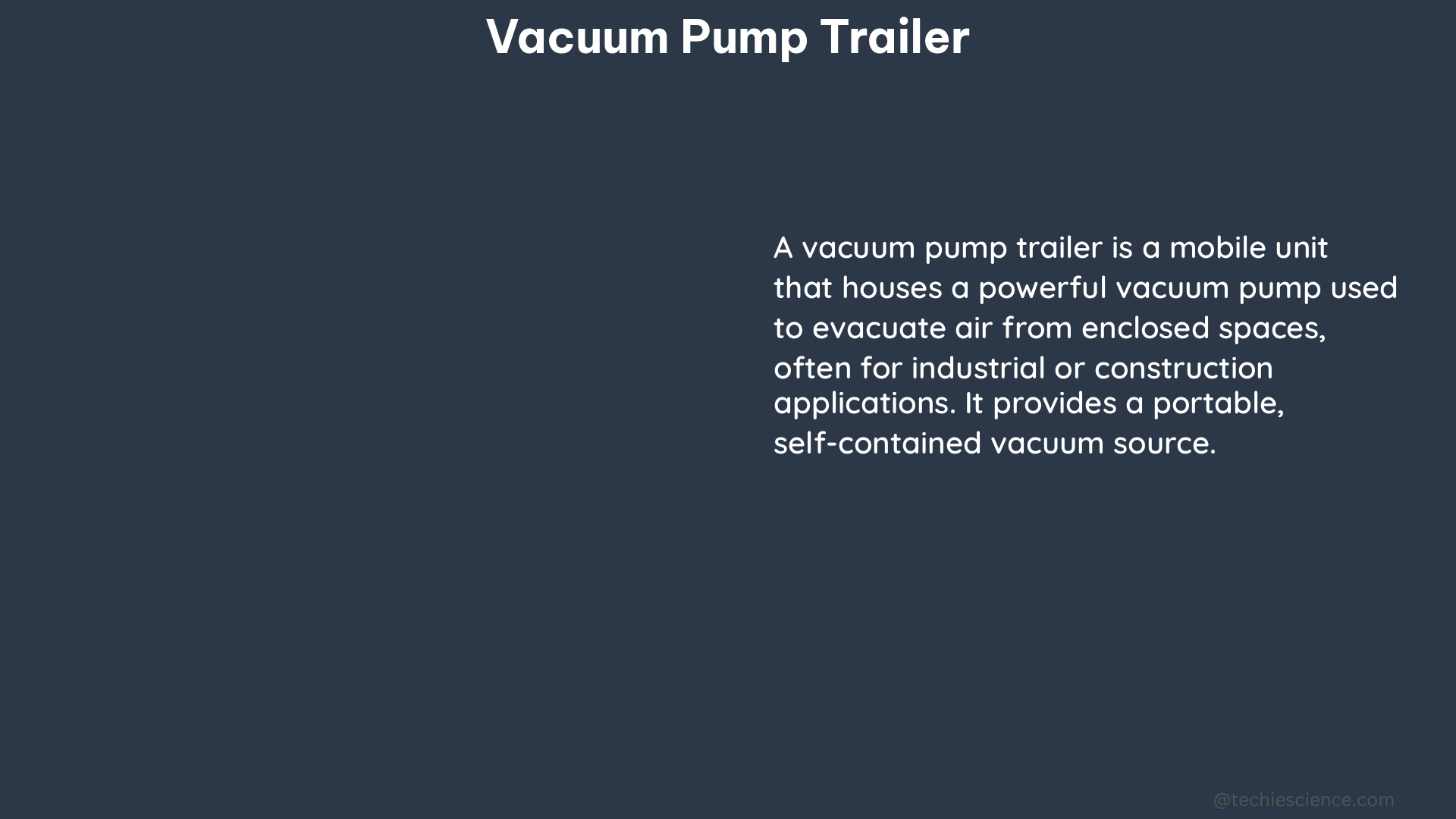A vacuum pump trailer is a specialized piece of equipment designed for high-suction pumping needs, such as handling grease waste, grit, wastewater containing solids, and other tough fluids. These trailers are essential in the context of wastewater facility construction, playing a crucial role in managing chemical toilets, campers, trailers, septic tanks, and vacuum-pump tank trucks, ensuring that discharge meets specific standards.
Understanding the Vacuum Pump Trailer
Vacuum pump trailers come in various sizes and capacities, with the TVP-115 Vacuum Trailer being a popular model, offering a capacity of 115 gallons. These trailers are equipped with high-suction vacuum pumps designed to handle demanding pumping tasks.
Vacuum Pump Specifications
The vacuum pump is the heart of the trailer, and its specifications are crucial for determining the trailer’s performance. Here are some key details to consider:
- Pump Type: Vacuum pump trailers typically use high-suction pumps designed for handling tough fluids, such as positive displacement pumps or rotary vane pumps.
- Pump Capacity: The pump capacity can vary widely, ranging from 115 gallons per minute (GPM) for the TVP-115 Vacuum Trailer to over 500 GPM for larger models.
- Pump Power: Vacuum pump trailers often use powerful engines, such as diesel or gasoline engines, to drive the vacuum pump. The engine size can range from 13 HP to 49 HP, depending on the trailer’s capacity and intended use.
- Vacuum Level: The vacuum level generated by the pump is a crucial factor, with typical vacuum levels ranging from 15 inches of mercury (inHg) to 28 inHg, allowing for effective suction of various waste materials.
Trailer Capacity and Dimensions
The capacity and dimensions of a vacuum pump trailer are essential considerations for its intended use and compatibility with various applications. Here are some typical specifications:
| Specification | Range |
|---|---|
| Capacity | 115 gallons (TVP-115 Vacuum Trailer) to 5,040 gallons (typical vac trailer capacity for hauling crude oil) |
| Length | 16 feet to 24 feet |
| Width | 8 feet to 8.5 feet |
| Height | 8 feet to 10 feet |
| Gross Vehicle Weight Rating (GVWR) | 10,000 lbs to 26,000 lbs |
It’s important to note that the capacity and dimensions can vary depending on the manufacturer and the specific model of the vacuum pump trailer.
Connection Types and Loading
Vacuum pump trailers may not always have drilock connections, which are common in other types of trailers. Instead, they often require loading from the rear using facility pumps. This means that the trailer’s connection type and loading process need to be considered when planning for its use.
Safety Measures
When using a vacuum pump trailer, especially for hauling crude oil, safety is of utmost importance. Proper grounding is essential to ensure safe operation, as vacuum truck pumps are not designed for safely moving crude oil like roper and hydraulic pumps.
Additionally, vacuum pump trailers are equipped with scrubbers, which are designed to help prevent overflow and maintain safe operation.
Building a DIY Vacuum Pump Trailer

For those interested in building their own vacuum pump trailer, it is crucial to consider the technical specifications and safety measures mentioned above. Here are some key factors to keep in mind:
- Vacuum Pump Selection: Choose a high-capacity vacuum pump that is suitable for handling the types of fluids you’ll be pumping. Consider the pump’s capacity, power, and vacuum level.
- Trailer Design: Determine the appropriate trailer size and dimensions based on your needs, ensuring compatibility with the vacuum pump and the intended use.
- Connection and Loading: Incorporate the necessary connection types and loading mechanisms to ensure efficient and safe operation.
- Safety Features: Implement proper grounding mechanisms and install scrubbers to enhance the safety of your DIY vacuum pump trailer.
- Regulatory Compliance: Ensure that your vacuum pump trailer design and operation comply with relevant regulations, such as the South Carolina Department of Health and Environmental Control’s Regulation 61-67.
By carefully considering these factors, you can build a DIY vacuum pump trailer that is both effective and safe for your specific needs.
Conclusion
Vacuum pump trailers are essential pieces of equipment for a wide range of applications, from wastewater facility construction to crude oil transportation. By understanding the technical specifications, safety measures, and regulatory requirements, you can design and build a DIY vacuum pump trailer that meets your needs and ensures safe and efficient operation.
References
- South Carolina Department of Health and Environmental Control’s Regulation 61-67
- Napa Sanitation District Code
- Waste Corporation’s TVP-115 Vacuum Trailer

The lambdageeks.com Core SME Team is a group of experienced subject matter experts from diverse scientific and technical fields including Physics, Chemistry, Technology,Electronics & Electrical Engineering, Automotive, Mechanical Engineering. Our team collaborates to create high-quality, well-researched articles on a wide range of science and technology topics for the lambdageeks.com website.
All Our Senior SME are having more than 7 Years of experience in the respective fields . They are either Working Industry Professionals or assocaited With different Universities. Refer Our Authors Page to get to know About our Core SMEs.